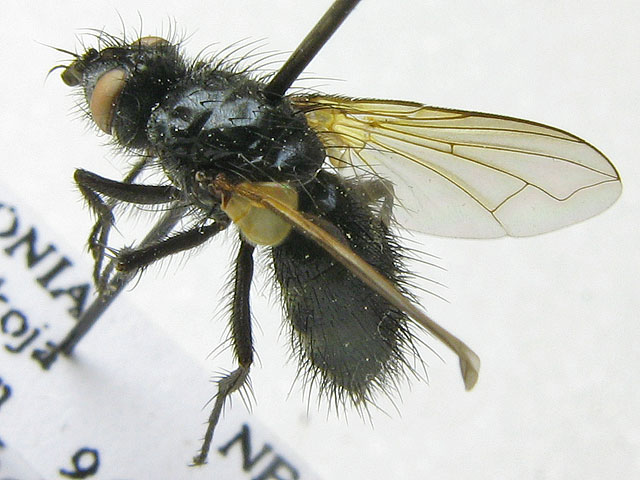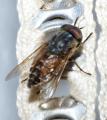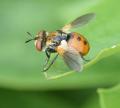Diptera.info :: Identification queries :: Diptera (adults)
Who is here? 1 guest(s)
|
Pseudopachystylum gonioides?
|
|
| ChrisR |
Posted on 15-12-2009 00:42
|
|
Administrator Location: Reading, England Posts: 7699 Joined: 12.07.04 |
I found 2 of these in a sample of tachinids from Estonia - they look quite distinctive - is this Pseudopachystylum gonioides? 
ChrisR attached the following image:  [61.95Kb] Manager of the UK Species Inventory in the Angela Marmont Centre for UK Biodiversity at the Natural History Museum, London. |
| ChrisR |
Posted on 15-12-2009 00:42
|
|
Administrator Location: Reading, England Posts: 7699 Joined: 12.07.04 |
another view...
ChrisR attached the following image:  [68.13Kb] Manager of the UK Species Inventory in the Angela Marmont Centre for UK Biodiversity at the Natural History Museum, London. |
| ChrisR |
Posted on 15-12-2009 00:43
|
|
Administrator Location: Reading, England Posts: 7699 Joined: 12.07.04 |
another view...
ChrisR attached the following image:  [68.73Kb] Manager of the UK Species Inventory in the Angela Marmont Centre for UK Biodiversity at the Natural History Museum, London. |
| Zeegers |
Posted on 15-12-2009 09:04
|
|
Member Location: Soest, NL Posts: 18532 Joined: 21.07.04 |
That looks OK to me, first impression Theo |
|
|
|
| ChrisR |
Posted on 15-12-2009 11:41
|
|
Administrator Location: Reading, England Posts: 7699 Joined: 12.07.04 |
Thanks Theo ... T&H says that it is quite elongate and distinctive, which this is ... but I thought I'd check anyway  On a quick glance it looks like a Zophomyia, until you realize that it has some dusting and the wing bases aren't yellow enough. It keys fairly easily so I am happy ... a nice 'new' species for me On a quick glance it looks like a Zophomyia, until you realize that it has some dusting and the wing bases aren't yellow enough. It keys fairly easily so I am happy ... a nice 'new' species for me 
Manager of the UK Species Inventory in the Angela Marmont Centre for UK Biodiversity at the Natural History Museum, London. |
| Jaakko |
Posted on 15-12-2009 16:05
|
|
Member Location: Joensuu, Finland Posts: 479 Joined: 04.08.08 |
Yes, quite distinct. I have three...  |
|
|
|
| neprisikiski |
Posted on 17-12-2009 22:18
|
|
Member Location: Lithuania Posts: 876 Joined: 23.02.09 |
Hi Chris, as for me "a nice 'new' species" sounds a little strange, very abundant here! Erikas |
|
|
|
| ChrisR |
Posted on 17-12-2009 22:38
|
|
Administrator Location: Reading, England Posts: 7699 Joined: 12.07.04 |
You are lucky! 
Manager of the UK Species Inventory in the Angela Marmont Centre for UK Biodiversity at the Natural History Museum, London. |
| neprisikiski |
Posted on 17-12-2009 22:50
|
|
Member Location: Lithuania Posts: 876 Joined: 23.02.09 |
Well, when you are "hunting" and 80 % of these, they make you angry 
Erikas |
|
|
|
| ChrisR |
Posted on 17-12-2009 23:40
|
|
Administrator Location: Reading, England Posts: 7699 Joined: 12.07.04 |
You are welcome to get rid of a few of your most troublesome tachinids - I can find a home for them!  We have around 270 species of tachinid here in the UK but most of those are now extremely rare (or possibly extinct) so the only way I can see some of "our" species is by gathering European samples 
Edited by ChrisR on 17-12-2009 23:41 Manager of the UK Species Inventory in the Angela Marmont Centre for UK Biodiversity at the Natural History Museum, London. |
| jorgemotalmeida |
Posted on 18-12-2009 02:02
|
|
Member Location: Viseu - PORTUGAL Posts: 9296 Joined: 05.06.06 |
ChrisR wrote: You are welcome to get rid of a few of your most troublesome tachinids - I can find a home for them!  We have around 270 species of tachinid here in the UK but most of those are now extremely rare (or possibly extinct) so the only way I can see some of "our" species is by gathering European samples  is there any study about this decline on tachinids in UK? It is rather strange... |
| ChrisR |
Posted on 18-12-2009 11:19
|
|
Administrator Location: Reading, England Posts: 7699 Joined: 12.07.04 |
Well, our recording scheme is plotting their current distributions and we have about 10,000+ records so far (even with the relatively small number of recorders). But what we lack is the historic data, from museum specimen data labels. We have personally transcribed the data from a few smaller, local museum collections but the big ones (London, NHM & Oxford, OUM) are just too far away and too large for us to work on.  Some day we hope to get some money to employ someone to work there and do it but that hasen't been forthcoming yet. Some day we hope to get some money to employ someone to work there and do it but that hasen't been forthcoming yet. Saying that, there might not be a massive decline. Just because Belshaw saw "50 records" doesn't say over how many years they were collected eg. 50 in the 1930s from all over England and none since? or 1 every year in the same place since 1950? Some tachinids happily exist in very low numbers or are just grossly under-recorded, even across Europe. Consider Opesia grandis, which has been seen very rarely over Europe (Peter Tschorsnig says he saw 2 in his life) but a friend of mine discovered it new to Britain a few years ago and now sees it in his garden every year!  Or Chetogena acuminata, which is extremely local and restricted to dry dune systems (especially around the North Sea & Baltic Sea) - seen at Winterton Dunes every year between 1929 and 1933 but never since ... is it extinct or has nobody been back to look for it at the right time of year? Same goes for Germaria angustata - restricted to Winterton Dunes and around the Baltic/North Seas - seen in the 1930s, 40s & 1 in the 1990s ... but it is also incredibly local across the whole northern hemisphere. Syd Cannings has been getting them in the Yukon (USA) on wind-blown glacial sand drifts (pers.comm.). Or Chetogena acuminata, which is extremely local and restricted to dry dune systems (especially around the North Sea & Baltic Sea) - seen at Winterton Dunes every year between 1929 and 1933 but never since ... is it extinct or has nobody been back to look for it at the right time of year? Same goes for Germaria angustata - restricted to Winterton Dunes and around the Baltic/North Seas - seen in the 1930s, 40s & 1 in the 1990s ... but it is also incredibly local across the whole northern hemisphere. Syd Cannings has been getting them in the Yukon (USA) on wind-blown glacial sand drifts (pers.comm.).Basically, we have a lot to learn and we will only do it by collecting more, databasing more and collaborating across the world 
Edited by ChrisR on 18-12-2009 11:33 Manager of the UK Species Inventory in the Angela Marmont Centre for UK Biodiversity at the Natural History Museum, London. |
| neprisikiski |
Posted on 18-12-2009 12:09
|
|
Member Location: Lithuania Posts: 876 Joined: 23.02.09 |
It is interesting for me that Peter Tschorsnig has rarely seen Opesia grandis, in some years I have collected a lot of them in Lithuania, but I noticed that they seem dissapearing, when previously cultivated and neglected meadows with dry conditions overgrow by a forest, or maybe its connected with some other reason. On the other hand, species as Periscepsia carbonaria, Stomina tachinoides and Thelymyia saltuum I have seen in historical Lithuanian materials only. I am interesting about the status of these three in the other countries? Erikas |
|
|
|
| Jaakko |
Posted on 18-12-2009 12:31
|
|
Member Location: Joensuu, Finland Posts: 479 Joined: 04.08.08 |
neprisikiski wrote: Hi Chris, as for me "a nice 'new' species" sounds a little strange, very abundant here! That's strange... I have one female from a window trap, one male reared from an unknown host on Pinus and one female that I caught last summer flying around a small pine tree on sand dunes. The big Pamphilid-wasps, which this guy is parasitizing are also not that common here! To my impression, this species is restricted to open, warm habitats with small pine trees here, so definitely not common! There are possibly only ten other findings from Finland. As other parasitoids, tachinids too have substantial variation in their numbers from year-to-year and place to place and many of them are hard to detect without some effort in malaise-trapping. Sometimes even this is not effective: Last summer I got only one Phytomyptera minutissima from a malaise trap on my yard, but collected 8 exx indoors on windows... To get any idea on the fauna just by active netting, one needs to have a lot of time on the field. |
|
|
|
| ChrisR |
Posted on 18-12-2009 14:27
|
|
Administrator Location: Reading, England Posts: 7699 Joined: 12.07.04 |
I think if you happen to live/collect next to some habitats that particularly favour certain species then they will appear 'common' but some tachinids seem to occur in very isolated, scattered colonies, often not closely linked with their known hosts. Many have common hosts but their distributions are still very restricted and little is known about their true requirements.  It's all fascinating stuff but we really need to get more malaise samples from more localities to better judge distributions. It's all fascinating stuff but we really need to get more malaise samples from more localities to better judge distributions.The Opesia grandis records are very interesting - back in 2006 (when Ivan Perry discovered it 'new to Britain' ) Peter Tschorsnig wrote to me: Opesia grandis is widespread in Europe (but - as far as known up to the present - obviously not in the typical hot Mediterranean or cold Northern countries). There are only scattered records everywhere so it must be regarded as a rare or very rare species (I never collected it by myself, Herting collected only a single specimen). Phytomyptera minutissima is also very rare here - discovered 'new to Britain' a few years ago - currently 2 records I think  
Edited by ChrisR on 18-12-2009 14:33 Manager of the UK Species Inventory in the Angela Marmont Centre for UK Biodiversity at the Natural History Museum, London. |
| Zeegers |
Posted on 18-12-2009 16:49
|
|
Member Location: Soest, NL Posts: 18532 Joined: 21.07.04 |
Species like Pseudopachystylum gonioides, Euexorista omumbrata and Opesia grandis have a rather eastern distribution. That does not mean they have never been found in the west, but still, much more common in the east. For example, I caught Euexorista in 3 weeks time in Estonia, whereas I can spend my whole life in the Netherlands looking for it. Theo |
|
|
|
| neprisikiski |
Posted on 18-12-2009 18:06
|
|
Member Location: Lithuania Posts: 876 Joined: 23.02.09 |
and what about three more species, Periscepsia carbonaria, Stomina tachinoides and Thelymyia saltuum, are they rarely collected in the other areas?
Erikas |
|
|
|
| Zeegers |
Posted on 18-12-2009 19:39
|
|
Member Location: Soest, NL Posts: 18532 Joined: 21.07.04 |
The first two are actually more southern, Periscepsia is mostly found on sandy shores or other very sandy places. Thelymyia is very rare Theo |
|
|
|
| neprisikiski |
Posted on 18-12-2009 20:40
|
|
Member Location: Lithuania Posts: 876 Joined: 23.02.09 |
The latter species ar known by me exclusively from the samples of Jan Prüffer, professor of Vilnius university, who have collected his material in the Vilnius Region (occupied by Poland), but after world war II have returned to Poland and created department of entomology in the university in Torun. He was actually resercher of Lepidoptera, so his material was reared very probably, while hosts of Stomina tachinoides and Thelymyia saltuum are not known...
Edited by neprisikiski on 18-12-2009 20:43 Erikas |
|
|
|
| Jump to Forum: |













